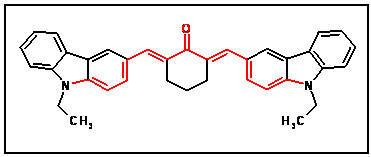2,6-Bis(9-ethyl-9H-carbazolylmethylene)cyclohexanone
Abstract
:
Supplementary materials
Supplementary File 1Supplementary File 2Supplementary File 3Acknowledgements
References and Notes
- Asiri, A.M. Synthesis and characterization of dyes exemplified by 2-arylidene-1-dicyanomethyleneindane. Dyes Pigm. 1999, 42, 209–213. [Google Scholar] [CrossRef]
- Rosso, V.; Loicp, J.; Renotte, Y.; Lion, Y. Optical non-linearity in Disperse Red 1 dye-doped sol gel. J. Non-Cryst. Solids 2004, 342, 140–145. [Google Scholar] [CrossRef]
- Cotter, D.; Manning, R.J.; Blow, K.J.; Ellis, A.D.; Kelly, A.E.; Nesset, D. Nonlinear optics for high-speed digital information processing. Science 1999, 286, 1523–1528. [Google Scholar] [CrossRef] [PubMed]
- Gaikwad, P. On the optical limiting and Z-scan of hexamethylin-dotricarbocyanine perchlorate dye. Opt. Mater. 2009, 31, 1559–1563. [Google Scholar] [CrossRef]
- Tardivo, J.P.; Giglio, A.D.; Oliveir, C.S.; Gabrielli, D.S.; Junqueira, H.C.; Tada, D.B.; Severino, D.; Turchiello, R.F.; Baptist, M.S. Methylene blue in photodynamic therapy: From basic mechanisms to clinical applications. Photodiagn. Photodyn. Ther. 2005, 2, 175–191. [Google Scholar] [CrossRef]
- Tonle, I.K.; Ngameni, E.; Tcheumi, H.L.; Tchieda, V.; Carteret, C.; Walcarius, A. Sorption of methylene blue on an organoclay bearing thiol groups and application to electrochemical sensing of the dye. Talanta 2008, 74, 489–497. [Google Scholar] [CrossRef] [PubMed]
- Prieto, I.; Fernandez, A.L.; Munoz, E.; Martin, M.T.; Camacho, L. Langmuir-Blodgett films containing water-soluble molecules: The methylene blue-dimyristoyl phosphatidic acid system. Thin Solid Films 2008, 284–285, 162–165. [Google Scholar] [CrossRef]
© 2009 by the authors; licensee Molecular Diversity Preservation International, Basel, Switzerland. This article is an open-access article distributed under the terms and conditions of the Creative Commons Attribution license (http://creativecommons.org/licenses/by/3.0/).
Share and Cite
Asiri, A.M.; Khan, S.A. 2,6-Bis(9-ethyl-9H-carbazolylmethylene)cyclohexanone. Molbank 2009, 2009, M635. https://doi.org/10.3390/M635
Asiri AM, Khan SA. 2,6-Bis(9-ethyl-9H-carbazolylmethylene)cyclohexanone. Molbank. 2009; 2009(4):M635. https://doi.org/10.3390/M635
Chicago/Turabian StyleAsiri, Abdullah M., and Salman A. Khan. 2009. "2,6-Bis(9-ethyl-9H-carbazolylmethylene)cyclohexanone" Molbank 2009, no. 4: M635. https://doi.org/10.3390/M635
APA StyleAsiri, A. M., & Khan, S. A. (2009). 2,6-Bis(9-ethyl-9H-carbazolylmethylene)cyclohexanone. Molbank, 2009(4), M635. https://doi.org/10.3390/M635




